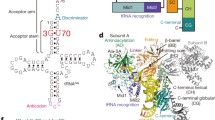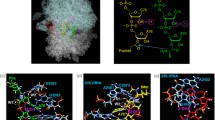Abstract
Recent reports suggest that the ribosome retains considerable peptidyl transferase activity even when much of the protein of the ribosome is removed and further suggests that rRNA may be the peptidyl transferase. The work here suggests that the AMP residue at the 3′ terminus of each tRNA has some catalytic activity both in the esterification reaction and in forming a pseudopeptide, AcGly, and further suggests that whatever peptidyl transferase is, it finds a cooperative substrate in the aminoacyl-AMP at the 3′ terminus of tRNA.
Similar content being viewed by others
References
Schimmel P: Aminoacyl tRNA-synthetases: general scheme of structure-function relationships in the polypeptides and recognition of transfer RNAs. Ann Rev Biochem 56: 125–158, 1987
Normanly J, Abelson J: tRNA Identity. Ann Rev Biochem 58: 1029–1050, 1989
Söll D: Accuracy of aminoacylation: Ensuring the fidelity of the genetic code. Review. Experentia 46: 1089–1096, 1990
Schulman LH: Recognition of tRNAs by aminoactyl-tRNA synthetases. Prog Nuc Acid Res Mol Biol 41: 23–87, 1991
Mirande M: Aminoacyl-tRNA synthetase family from prokaryotes and eukaryotes. Prog Nuc Acid Res Mol Biol 40: 95–142 1991
Carter CW Jr: Cognition, mechanism, and evolutionary relationships in aminoacyl-tRNA-synthetases. Ann Rev Biochem 62: 715–748, 1993
Lacey JC Jr, Wickramasinghe NSMD, Cook GW: Experimental studies on the origin of the genetic code and the process of protein synthesis. Orig Life Evol Biosph 22: 243–275, 1992
Noller HF: Ribosomal RNA and translation. Ann Rev Biochem 60: 191–227, 1991
Noller HF, Hoffarth V, Zimniak L: Unusual resistance peptidyl transferase to protein extraction procedures. Science 256: 1416–1419, 1993
Lacey JC, Staves MP, Thomas RD: Ribonucleic acids may be catalysts for preferential synthesis of L-amino acid peptides. J Mol Evol 31: 244–248, 1990
Goldberg S: On the function of the 2′ hydroxyl group of the tRNA terminus during peptidyl elongation in ribosomal peptide biosynthesis. Bioorganic and Medicinal Chem Lett 3: 1527–1530, 1993
Gottikh BP, Krayevsky AA, Tarussova NB, Purygin PP, Tsilevich TL: The general synthetic route to esters of nucleosides, nucleotides and nucleoside-5′-triphosphates and some properties of these compounds. Tetrahedron 26: 4419–4433, 1970
Lacey JC Jr, Thomas RD, Wickramasinghe NSMD, Watkins CL: Chemical esterification of 5′-AMP occurs predominantly at the 2′ position. J Mol Evol 31: 251–256, 1990
Wieland T, Merz H, Pfleiderer G: About peptide synthesis XXII. The reactivity of amino acid glycol esters. Chem Berichte 93: 1816–1821, 1960 (in German)
Zachau HG: Reactions of amino acid esters as models of aminoacyl-RNA, I. IBID 93: 1822–1830 1960 (in German)
Zachau HG, Karau W: Reactions of amino acid esters as models of aminoacyl-RNA, II. IBID 93: 1830–1839, 1960 (in German)
Oro J: Synthesis of adenine from ammonium cyanide. Biochem Biophys Res Comm 2: 407–412, 1960
Author information
Authors and Affiliations
Rights and permissions
About this article
Cite this article
Wickramasinghe, N.S.M.D., Lacey, J.C. Catalytic roles of the AMP at the 3′ end of tRNAs. Mol Cell Biochem 139, 117–121 (1994). https://doi.org/10.1007/BF01081734
Received:
Accepted:
Issue Date:
DOI: https://doi.org/10.1007/BF01081734




